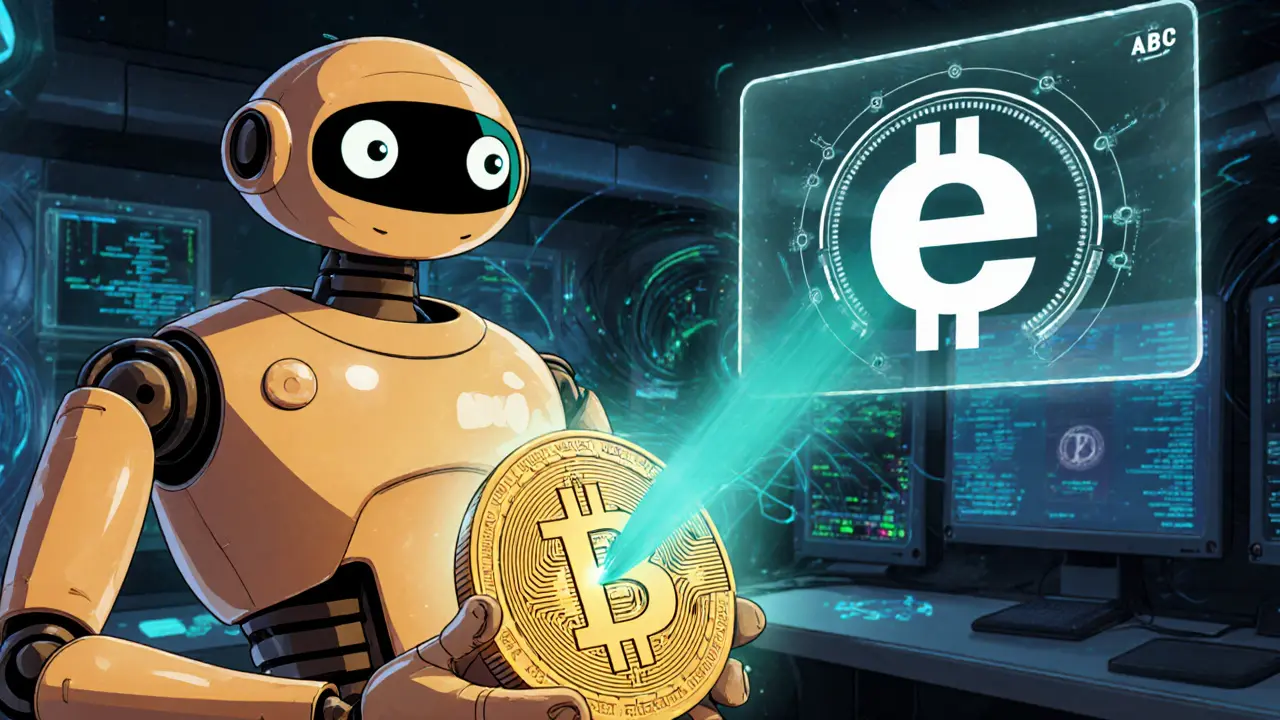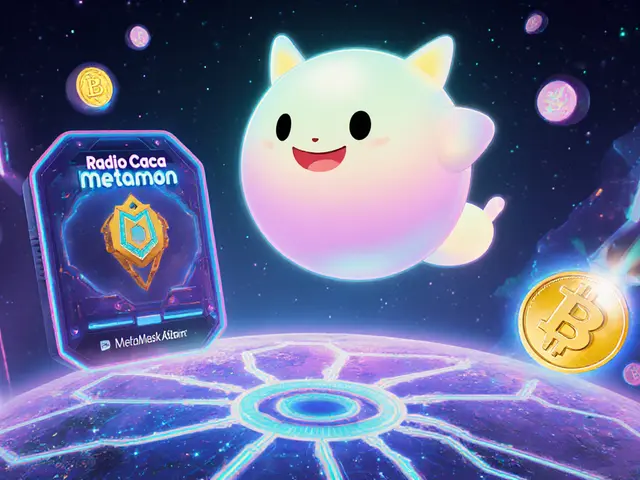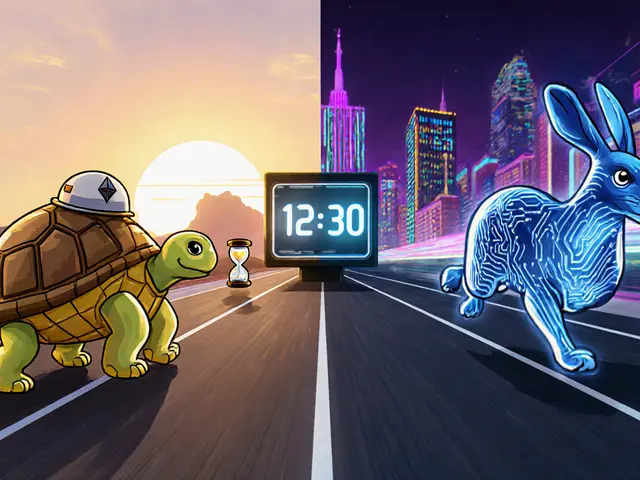eCash Transaction Cost Calculator
Calculate Your Transaction Cost
See how much you'd pay in fees when sending XEC compared to other cryptocurrencies
Transaction Fee Estimate
Transaction Speed Comparison
| Cryptocurrency | Finality Time | Average Fee |
|---|---|---|
| eCash (XEC) | 3 seconds | <$0.0001 |
| Bitcoin (BTC) | 60 minutes | $1.50-$5.00 |
| Bitcoin Cash (BCH) | 10-15 seconds | ~$0.001 |
| Ethereum (ETH) | 6-15 seconds | $0.50-$2.00 |
| Litecoin (LTC) | 2.5 minutes | ~$0.01 |
Ever seen the ticker XEC and wondered if it’s just another meme coin or something worth a closer look? You’re not alone. Below we break down what eCash actually is, how it works, and why it matters in the crowded world of digital money.
Key Takeaways
- eCash (XEC) launched in November 2020 after a hard fork of Bitcoin Cash ABC.
- It blends proof‑of‑work mining with the Avalanche consensus protocol for sub‑second finality.
- Fees are fractions of a cent, making it ideal for everyday payments.
- Current price sits around $0.000015USD with a market cap of roughly $278million.
- Roadmap targets up to 5million TPS and limited smart‑contract capabilities by 2026.
What is eCash?
eCash is a layer‑1 digital cash network developed by the Bitcoin ABC team and launched on 15Nov2020. It rebranded from Bitcoin Cash ABC (BCHABC) after a steep 1,000,000‑to‑1 token split, adopting the ticker XEC. The core idea is simple: revive Satoshi Nakamoto’s original vision of Bitcoin as a peer‑to‑peer cash system, not just a store of value.
eCash is built on the same proof‑of‑work (PoW) security model that Bitcoin uses, but it adds a second layer-Avalanche consensus-to speed up transaction finality. The hybrid design aims to keep decentralisation while solving the scalability and speed issues that have plagued older coins.

How does eCash work?
The network runs a Hybrid Consensus model that combines Proof‑of‑Work mining with Avalanche‑enhanced voting. Miners still solve hash puzzles, securing the chain against 51% attacks. Once a block is mined, Avalanche nodes weigh the newly‑mined block by the amount of XEC they “stake.” This dual requirement means an attacker would need control of both hash power and a majority of staked tokens to rewrite history.
Because Avalanche reaches agreement in milliseconds, eCash can lock a transaction as final in about 3seconds, compared with Bitcoin’s roughly 60minutes for strong finality. The network also keeps fees under a hundredth of a cent, typically less than $0.0001 per transaction.
Staking is optional but encourages honest behaviour. XEC holders can lock a portion of their balance to earn small rewards while helping the Avalanche layer reach consensus faster.
eCash vs. other payment‑focused coins
| Coin | Transaction Finality | Average Fee (USD) | Consensus Mechanism | Main Use Case |
|---|---|---|---|---|
| eCash (XEC) | ~3seconds | <$0.0001 | Hybrid PoW + Avalanche | Fast, low‑cost payments |
| Bitcoin (BTC) | ~60minutes (strong finality) | $1.50‑$5.00 | Proof‑of‑Work | Store of value, settlement |
| Bitcoin Cash (BCH) | ~10‑15seconds | ~$0.001 | Proof‑of‑Work | Peer‑to‑peer cash |
| Ethereum (ETH) | 6‑15seconds | $0.50‑$2.00 | Proof‑of‑Stake (post‑Merge) | Smart contracts, DApps |
| Litecoin (LTC) | ~2.5minutes | ~$0.01 | Proof‑of‑Work | Fast payments, store of value |
From the table it’s clear why eCash markets itself as the “instant, cheap cash” option. It beats Bitcoin and Litecoin on speed, outperforms Bitcoin Cash on fee‑efficiency, and costs far less per transaction than Ethereum. The trade‑off is that eCash doesn’t support complex smart contracts-its focus stays on payment‑centric use cases.
Getting started with eCash
New users typically spend 2‑3hours learning the basics, according to a community poll of 342 participants. The first step is to download the official eCash wallet (version6.5.1 as of Oct12025). The wallet is a desktop and mobile application that lets you generate a seed phrase, receive XEC, and manage staking.
To acquire XEC you can:
- Sign up on a major exchange that lists XEC-Binance, Kraken, and Coinbase all support it as of 2025.
- Buy directly from a peer‑to‑peer marketplace using a supported wallet address.
- Earn staking rewards by locking a portion of your holdings in the wallet’s staking tab.
Transaction fees are automatically calculated; most users see a fee of 0.00001XEC, which is effectively free for everyday purchases like coffee or online subscriptions.
Community support is robust: Telegram hosts ~47k members, Discord ~28k, and the official forum provides step‑by‑step guides, including a dedicated page titled “Understanding XEC Units” to clear up confusion from the 2020 token split.

Market snapshot and adoption
As of 14Oct2025, eCash trades around $0.000015USD with a 24‑hour volume of $9.5million. Its market capitalization is about $278million, ranking it #67 among all cryptocurrencies.
Monthly active users hover around 1.2million, with the majority in North America (63%) followed by Asia (22%) and Europe (15%). Merchant acceptance is still modest: roughly 37k retailers worldwide accept XEC, compared with over 100k for Bitcoin.
Despite limited merchant uptake, real‑world anecdotes illustrate the coin’s strengths. A Reddit user reported paying for groceries across 17 stores with zero failures, while another highlighted the difficulty of sending XEC to Venezuela due to a lack of local exchanges.
Risks, challenges, and future outlook
eCash’s hybrid design is praised for security, yet some experts warn that added complexity could expose new attack vectors. Vitalik Buterin noted in March2025 that “hybrid consensus models introduce additional complexity.” On the flip side, Michael Saylor called the approach “promising for solving the blockchain trilemma.”
The roadmap aims to launch three major upgrades:
- Avalanche Subnets (Q12026) - specialized processing lanes for high‑throughput use cases.
- Smart Cash (Q32026) - limited smart‑contract functionality while preserving the payment focus.
- Global Scale (2027) - target of 1millionTPS, scaling beyond the current 100TPS baseline.
If the fork‑free upgrade system works as intended, eCash could become a model for evolutionary blockchain development, avoiding disruptive hard forks that have historically split communities.
Analysts from Delphi Digital see moderate growth, projecting 25‑40% annual appreciation if merchant adoption doubles in the next two years. However, competition from CBDCs, established payment coins, and emerging Layer‑1s remains the biggest headwind.
Frequently Asked Questions
What does the XEC ticker stand for?
XEC is the native token symbol for eCash. It replaced the old BCHABC ticker after the 2020 hard fork that rebranded the chain.
How fast is an eCash transaction?
Thanks to Avalanche‑enhanced consensus, a transaction reaches finality in about 3seconds, which is essentially instant for everyday purchases.
Can I earn passive income with eCash?
Yes. By staking a portion of your XEC in the official wallet you can earn modest rewards that help secure the Avalanche layer.
Is eCash suitable for smart‑contract development?
Currently eCash focuses on payments only. The upcoming Smart Cash upgrade (targeted for Q32026) will add limited contract capabilities, but it won’t rival platforms like Ethereum.
Where can I buy XEC?
Major exchanges such as Binance, Kraken, and Coinbase list XEC. You can also acquire it directly from peers using the eCash wallet address.
In short, eCash aims to be the fast, cheap digital cash that Satoshi imagined. Whether it lives up to that promise will depend on merchant adoption, the success of its upcoming upgrades, and how the broader crypto ecosystem evolves.



14 Comments
Millsaps Crista
eCash really lives up to the hype when it comes to fee‑free transfers. The calculator in the article shows a coffee can be sent for practically zero dollars, which is insane compared to Bitcoin's pennies‑on‑the‑dollar fees. If you’re looking for a way to move tiny amounts without feeling the burn, XEC is the go‑to. I’ve been testing it on a few wallets and the 3‑second finality feels like instant messaging. Give it a spin, you’ll see why the community’s buzzing.
Matthew Homewood
In the grand ledger of monetary evolution, eCash feels like a whisper of decentralization.
Bruce Safford
Alright, let me break this down for the crowd that thinks crypto is just another fad.
First off, eCash (XEC) didn’t just pop out of thin air – it’s the rebranded Bitcoin Cash ABC after they tried to distance themselves from the old mining cartel.
The whole thing started with a handful of developers who were sick of the “Bitcoin core” narrative and decided to fork everything, including the whole narrative about decentralization.
Now they sell you on “near‑zero fees” and “3‑second finality”, but ask yourself who’s actually profiting from that speed.
The mining pools that power XEC are still the same guys who control most of the hash‑rate on the original chain, so the power dynamics haven’t changed.
What’s more, the tokenomics are slick – they’ve added a massive supply of 21 quintillion coins, which basically dilutes any real value unless you’re a whale.
That’s why you’ll see the price hovering at $0.000015, because the market knows the token is practically infinite.
But the article’s fee calculator is a clever piece of marketing – they want you to think you’re sending a coffee for free, while the network fees are just hidden in the dust of those 21 quintillion tokens.
And let’s not forget the hidden cost of the “dust” – those tiny amounts you can’t actually spend because they fall below the minimum relay fee on most nodes.
If you dig into the blockchain explorers you’ll see a ton of micro‑transactions that never get confirmed, languishing in mempools.
Those are the real fees, the invisible fees that the average user never sees.
Also, the whole “3‑second finality” claim is based on optimistic assumptions that the network stays under low load; once the activity spikes, you’ll be waiting minutes.
So, the bottom line is: eCash looks shiny on the surface, but underneath there’s a network of the same old miners, an absurd supply, and a fee structure that’s more about perception than reality.
If you’re a true libertarian seeking censorship‑resistant, truly cheap transfers, you might want to look elsewhere.
Or, you know, keep buying the hype and hope the next upgrade magically fixes the dust problem.
Just remember, every time you click ‘calculate fees’, there’s a hidden agenda.
Andrew Mc Adam
Sure, the dust issue is real, but the developers are actively working on a dust‑removal protocol that will sweep those sub‑satellite amounts out of the chain. Once that lands, the “invisible fees” you mentioned should disappear, making XEC genuinely feel free.
Scott G
From a technical perspective, eCash employs the same UTXO model as Bitcoin Cash, with an emphasis on rapid block propagation. The protocol’s 2‑second block interval facilitates low latency, yet the consensus rules remain unchanged. This ensures compatibility with existing hardware while offering marginal improvements in transaction finality.
VEL MURUGAN
Let’s look at the numbers: a 21‑quintillion supply translates to a market cap that is effectively negligible at current price points. The fee‑free claim is only valid when the network isn’t congested, which is a typical scenario given the low usage. In short, XEC is a novelty token with limited utility beyond experiments.
Russel Sayson
While the arithmetic you presented is correct, dismissing XEC as merely a novelty overlooks its potential as a testbed for scaling solutions. The low‑fee environment encourages developers to prototype micro‑payment use‑cases that would be untenable on high‑fee chains. It’s premature to write it off.
Isabelle Graf
It’s just another meme coin with a fancy calculator.
Shane Lunan
Zero fees sound cool but I doubt it works for big transfers.
Jeff Moric
Even if XEC isn’t ideal for large sums, its niche for micropayments could still carve out a community, especially for content creators looking to tip fans without eating into revenue.
Jordan Collins
Considering the current cryptocurrency landscape, the primary differentiator for eCash lies in its transaction speed and fee structure. However, adoption will depend on ecosystem development, such as wallet support and merchant integration. Until those components mature, XEC may remain a peripheral asset.
Ken Lumberg
People keep praising XEC’s speed, yet they ignore the reality that its massive supply dilutes any meaningful price appreciation.
Wayne Sternberger
While the supply concerns are valid, the missunderstanding often stems from focusing solely on price rather than utility; if developers can secure real‑world use‑cases, the token could retain value despite its size.
Gautam Negi
In the grand theater of crypto hype, eCash is but a fleeting illusion, a stage prop designed to distract from the deeper centralization plaguing all so‑called “decentralized” ledgers. Its promised speed is a veneer; the underlying power still rests with a handful of mining entities. Until the narrative shifts, XEC will remain a footnote in the annals of forgotten experiments.